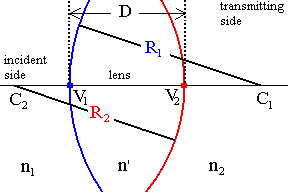

In the preceding discussion we were able to describe the passage of a ray from one point to another in a simple optical system by means of two translation matrices and one refraction matrix. A more complicated optical system may contain many refracting surfaces of different indices of refraction. Let us first consider a single lens. It consists of two refracting surfaces in series.

Assume that a ray characterized by r1 on the incident side at the interface is refracted at the first surface. The refraction matrix is R1. At the first surface, inside the lens, the ray is characterized by r1’ = R1r1. At the second interface the ray is characterized by r2 = T12r1’ = T12R1r1. It is now refracted at the second interface and is characterized by r2’ = R2r2 at the interface on the transmitting side.
These three matrices may be multiplied together to give one two by two matrix M = R2T12R1. All the necessary information about the optical system is included in this resultant two by two matrix. The determinant of this matrix is 1.
The matrix R1 is given by
 ,
,
the matrix T12 is given by
 ,
,
and the matrix R2 is given by
 .
.
For the lens shown above R2 is negative.
This yields by matrix multiplication
We now can trace a ray from vertex V1 to vertex V2 of a single lens.
![]()
When we let D go to zero the transmission matrix becomes
 ,
,
where Pthin = P + P’ = (n’- n1)/R1 + (n2 - n’)/R2. If n1 = n2 = 1, then
 .
.
This is called the lens maker’s equation.
Mthin has the same form as the matrix for refraction at a single interface. If we substitute Pthin for P, equation 4 gives us the relationship between the object and the image position for a thin lens. If n1 = n2 = 1, then f = f’ = 1/Pthin and
 .
.
![]()
Explore ray tracing using Microsoft Excel. The linked spreadsheet traces rays across a single spherical lens in the paraxial approximation using matrix multiplication. It contains a macro, which increments the launch angle for 7 rays. The results of the calculations are plotted. The object position, the radii of the lens and the indexes of refraction of the lens and the surrounding material can be chosen by the user. Please explore the spreadsheet and feel free to modify it.